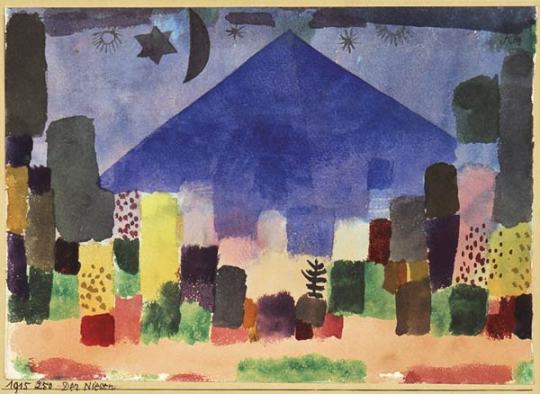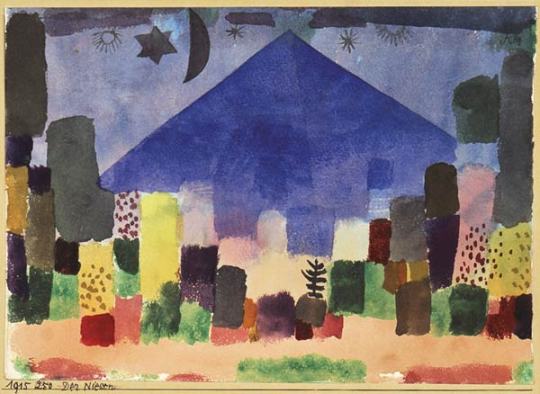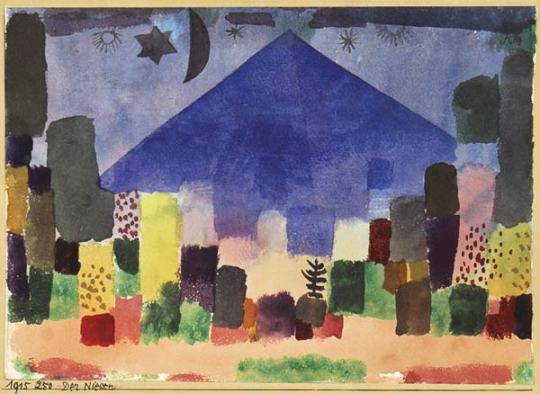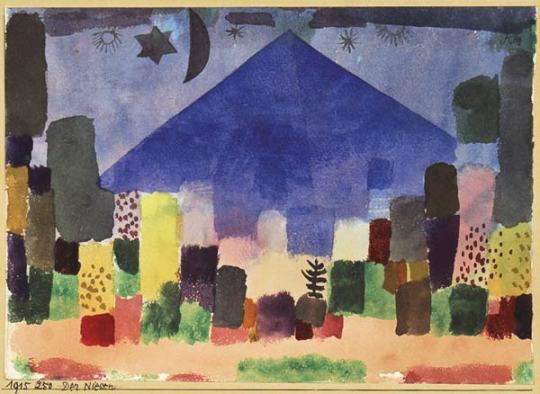#mount niesen
Photo

Mount Niesen, 1915, Paul Klee
Medium: watercolor
65 notes
·
View notes
Text
Manchmal stellt man Dinge auf ein Podest und kommt nie wieder ran und die Dinge fangen Staub und man sitzt einfach darunter und betet sie an – jahrelang. Doch irgendwann muss man niesen, wegen dem ganzen Staub – und ‚Hatschi!’ Niest die Dinge vom Podest und wenn die Trauer vergeht, ist Platz für Neues. Das Leben ist okay, es meint es gut mit dir und dann packt man seine Koffer und verlässt den Mount Murphy und das Marie-Byrd-Land für immer. Nur in der Ferne funkeln Sterne.
Meackes - Marie-Byrd-Land
0 notes
Text
Shanghai-New York Twin Cities Theater Forum
Shanghai-New York Twin Cities Theater Forum
By Alex Roe

Convened in a spirit of civic boosterism and international sister city comradery, if some measure of sibling rivalry, the inaugural Shanghai-New York Twin Cities Theater Forum took place on July 12, 2019. An all-day affair at the Huang pu theater in Shanghai’s Huangpu district, the city’s economic and administrative center, the forum featured an array civic leaders from Shanghai and experts in their respective cultural fields from Shanghai and New York. Before an audience of students, scholars, and local arts and civic leaders, the 17 speakers engaged one another with brief addresses, followed by two very brief panel discussions, as well as lunch, tea, and an ample dinner to follow.
In my capacity as Producing Artistic Director of New York’s Metropolitan Playhouse—a resident theater in Manhattan’s East Village—I was more than honored to be one of the featured speakers, and only too happy to spend several days by my own lights beginning to know the City by the Sea as a guest of the generous Shanghai Theatre Academy.

A little background from the event’s program: In 2018, with an eye to “accelerate the high quality development of the Peoples Square theater cluster,” the Publicity Department of the Municipal Government and the Huangpu District Government christened a new initiative “Show Life,” the civic brand around which to develop “an active zone of performing arts with the ‘highest’ theatre density, the ‘biggest’ clustering effect, the ‘strongest’ collaboration, the ‘widest’ market space and the ‘best’ service environment.”

As a contribution to the Show Life mission, Prof. Huang Changyong, president of the Shanghai Theatre Academy, conceived of an annual forum bringing together New York and Shanghai theater experts to exchange perspectives on their respective cities’ theaters. Prof. Huang is uniquely positioned to do so. Established in 1945, the Shanghai Theater Academy (formerly the Shanghai Municipal Experimental Drama School) is a school for professional theater and dance training, as well as study of literature and arts management. The academy is also home to the Marvin Carlson Theatre Center, an office and workspace named for the renowned CUNY Graduate Center scholar and devoted to academic exchange and research between Asia and the Americas through structured cooperation between CUNY and STA. Seminars, courses, symposia and conferences are offered under the aegis of the Center, and it has coordinated study in New York for scholars from Shanghai, as well as instruction in Shanghai by CUNY PhD students and faculty.
Building on this collaboration between the two institutions, President Huang invited Dr. Carlson to gather four New York theater mavens to describe our respective institutions in relation to New York City and its theater. Joining us were Dr. Carlson himself and two officials of the Carlson Center, one based in Shanghai, the other in New York. Altogether, 7 New York and 10 Shanghai delegates, each simultaneously translated, presented their visions of their respective cities’ theater cultures, now and to come.
Over the course of the day, one recalled Oscar Wilde’s framing, that bankers discuss Art, while artists discuss Money, if his quip might be refracted through the lenses worn by the ambitious civic and cultural shapers, on the one hand, and those of the presumed enshrined cultural leaders on the other. The Chinese speakers spoke of money, envisioning the promise of the theater industry in Shanghai, taking as their model a light and power that reaches around the globe, in both cultural prestige and economic strength: Broadway. Meanwhile, the New York speakers—largely artists and scholars in their own right—focused mostly on the content and intent of their art.
Shanghai presenters offered vision and perspective from the promotional to the analytic to the theoretical. With a sleek and energizing video promotion, Cao Xiaomin, Deputy Director of the Publicity Department of the Huangpu District, presented Show Life as a promotion and development effort to build a vibrant theater to equal Broadway, drawing the most elite performers to create the highest level productions in a new era of cultural accomplishment for the cosmopolitan city.
Kaiqi Hu, translator, dramaturg, and Liason Officer of the Carlson Center at the Shanghai Theatre Academy, offered a slide presentation illustrating Shanghai producers’ ability to mount confident Chinese productions of Tony-winning Broadway shows.
Founding his presentation on Abraham Maslow’s hierarchy of human needs, Tu Qiyu, Deputy Director of the Institute of Urban and Population Development at the Shanghai Academy of Social Sciences addressed the need for civil and economic development to adequately support culture, and notably theater, as a part of a fully self-actualized contemporary city’s identity—essential for a city to be an international leader.
He Jianhua, Former Vice President of the Shanghai Academy of Social Sciences, gave a diverting and aspirational description of a Shanghai as historically a cultured city that must continue its development, setting its American sister as a “benchmark.” Such a city could not be, in his words, a handsome and muscled boy with an underdeveloped brain—attractive perhaps, but not one the girls would like—but rather worthy of recognition and equal to its international comrade, a “new New York.”
Ye Changhai, Professor of Dramatic Literature at the Shanghai Theater Academy, took a 40 year historical perspective and reflected on the Chinese stage as recovering from the crisis of the Cultural Revolution.
Sun Wenqian, Executive Director of The Power Station of Art, articulated the need for cross border communication and sharing of influences.
Zhou Hanmin, Vice Chairman of the China Democratic Construction Association and Vice Chairman of the Shanghai Political Consultative Conference, framed an enthusiasm for the energy of the urban environment, for the promise of open and inclusive culture, for the importance seeing culture as an industry, and for an embrace of pluralism. He also took a surprisingly direct aim at “my country firstism” and condemned efforts to “make a country great” that depended on preventing another country’s thriving.
Chen Chao, Director of the Shanghai Library, articulated a vision of the library’s role in preserving and promoting culture, with particular focus on the development of artificial intelligence, questions of the nature of inspiration and creation, and the potential of big data in relation to these questions.
Bao Yaming, Director of Technology and Humanity Research Unit of the Literature Department at the Shanghai Academy of Social Sciences, chose as a case study the Punchdrunk Theater’s Sleep No More -—currently playing in Shanghai and assuredly appraised as “better than New York”—to show how the impact of cultural offerings may be measured and quantified as economic and civic forces. Replete with demographic studies and thermal imaging maps of the city, he demonstrated how patrons, citizens—consumers—were drawn to cultural districts, and commerce and industry are driven by theatrical offerings.
Wang Guowei, Director of the Institute of Art and Media Industry at Tongji University, prioritized the understanding of space as the most important topic for a discussion of theater and culture, a refreshingly theoretical approach to a practical consideration. His talk ranged from considerations of rural and urban spaces, and different types of space, informed by the intersections of our physical with our psychological experience.
Fan Yong, Director of the Asian Institute of Art and Finance, described a mutual reinforcement of financial services and cultural empowerment, citing auction trends in the art market and a thumbnail history of financial support for the fine arts. Interspersed among these corporate presentations were the New York speakers.
Marvin Carlson described the Theatre Center named for him at the Shanghai Theater Academy, its history, philosophy, and programs in international exchange.
To give a sense of the breadth of theatrical offerings in New York, Peter Eckersall, Professor of Theatre Studies at The CUNY Graduate Center (and Deputy Director of the Marvin Carlson Theatre Center at STA), provided an overview of the many different types of production activity there, from off-off-Broadway to Broadway, explaining the defining influence of professional unions and geography on the different categories, and then described the work of a few of the least conventional theater producers.
Jacqueline Z. Davis, Executive Director of the New York Public Library for the Performing Arts, painted a comprehensive picture of the library’s participation in New York’s theater culture through its work as an educator, not only through housing unique and historically valuable resources for research, but also through numerous workshops, performances, exhibitions, and new media creations.
Kate Loewald, Artistic Director of The Play Company, provided an overview of the history of her company and its dedication to introducing new work and international collaborations to New York, followed by a detailed description of two exemplary productions.
Jim Niesen, Artistic Director of Irondale Ensemble Project, spoke of the challenges of producing non-profit theater in New York and the artist’s role as both a “canary in the coalmine” and the sparring partner with culture, bound to speak to the current moment and announce civic and social concerns.
As Producing Artistic Director of Metropolitan Playhouse, I framed the work of Metropolitan Playhouse in context of America’s familiar history and mythology, proposing the rediscovery of forgotten plays and perspectives to be a valuable a reminder of the foundation, challenges, and promises of the past that can be lost in a nation whose defining character is defiance and reinvention.
Following the individual addresses were two brief round tables, the asking what Show Life might learn from Broadway as an industry, the other more broadly comparing the cultural dynamics of the two cities.
Out of this cordial and optimistic gathering emerged a few dominant impressions. The one is a concerted will among the Shanghai sponsors and speakers to see Shanghai as filled with ambition, energy, talent, and promise. The city in this light may be measured against the reputation of New York and found possessed of equal dynamism and skill, ready to take its place in the sun alongside, if not a step above, its American sister.
A second, corollary to the first, is the aspiration to attain the commercial, artistic, and reputational success of Broadway, by learning the practical tools and techniques that support that industry and so reproduce Broadway in Shanghai.
Meanwhile, in response to these assertions, comes a third, held by many of the New York guests and optimistically shared with the hosts: that the dynamism of New York theater depends on its engagement with its local circumstance, and often that which is not Broadway. Alongside those commercial productions are theaters, producers, and artists thriving Off- and Off-Off-Broadway, reaching audiences with work ranging in size, subject, style, and target audience. Indeed, through their work developing new productions, embracing challenging subjects, cultivating new talents, daring new performance styles, and exciting local audiences, these theaters provide glittering, internationally famous Broadway its most enduring and enlivening work.
A professional director for 37 years, Alex Roe studied literature and theater at Harvard University. He began his career directing, acting, writing, and teaching for theaters across the United States and abroad, often producing new English adaptations of Western classics. In 2001, he became Producing Artistic Director of Metropolitan Playhouse, a company in New York City devoted to exploring American culture and history through America’s theater. He has directed 35 productions at Metropolitan, and under his leadership, the theater has consistently been described in the press as an “invaluable” cultural institution.
Alex Roe
Artistic Director
Metropolitan Playhouse
Finding America, One Play at a Time
www.metropolitanplayhouse.org
212 995 8410
1 note
·
View note
Photo

Mount Niesen by chbD Source: http://bit.ly/2Jz2pkw
#visitswitzerland#CHB Photography#DJI#DJI Mavic#DJI Mavic 2 Pro#Wimmis#aerial#alps#amazingswitzerland
0 notes
Quote
Manchmal stellt man Dinge auf ein Podest
Und kommt nie wieder ran
Und die Dinge fangen Staub
Und man sitzt einfach darunter und betet sie an – jahrelang
Doch irgendwann muss man niesen
Wegen dem ganzen Staub – und ‚Hatschi!’
Niest die Dinge vom Podest
Und wenn die Trauer vergeht, ist Platz für Neues
Das Leben ist okay, es meint es gut mit dir
Und dann packt man seine Koffer
Und verlässt den Mount Murphy
Und das Marie-Byrd-Land
Für immer
Nur in der Ferne funkeln Sterne
Maeckes
#falling out of love#maeckes#quote#marie-byrd-land#podest#lyrics#poetry#poets on tumblr#poesia#i dont love you#i dont love you anymore#heartbroken#break up#relationship#over#done#deutscher hiphop#rap#hiphop#sterne#stars#breaking up
3 notes
·
View notes
Photo

Mount Niesen, View from Lake Thun near Interlaken, Switzerland [6000x4000] [OC] via /r/EarthPorn https://ift.tt/2Tm8kxP
0 notes
Photo

From Lake Thun until Mount Niesen by chbD // Let's get back a bit more in our evening drone flight "competition". In that time the sun was already in a very low position, but there was still enough sun to have light for great pictures. With the sun in the deep position it was also possible to us the sun as backlight or lens flare. There are actually a few nice pictures which I like, and it's hard for me to choose which of those pictures is the best one. May I get your help? Just leave a comment what you like or dislike in this picture series.
0 notes
Text
GILAS ACTIONS DEPLORABLE, BUT…
by Bert A. Ramirez / July 8, 2018

Let’s play a game by reversing the roles played by the Gilas Pilipinas and Australian national teams during their faceoff in the third window of the FIBA Asia/Pacific qualifiers for the 2019 FIBA World Cup last Monday, July 2, 2018, that was marred by an ugly brawl. This is to somehow put one group in the other group’s shoes to find out what the first group would have done under the same circumstances.
Let’s assume, for example, that Gilas Pilipinas was playing in Melbourne, and, during its first practice at the host country’s homecourt, it didn’t find the advertorial stickers on the home floor conducive to playing and quickly made an effort to remove them without even telling the hosts about its intent and why. This was caught on the CCTV camera and reached the host Australians’ basketball federation.
Then, in the warmup just before the game, the Filipinos made physical contact with some Australians who inadvertently strayed into their half of the court, as if saying, “You have no business crossing over to our half of the court as this territory is ours.” They also complement this with racist remarks as “kangaroos” and “gangling beanpoles” (the equivalent of the alleged Twitter tweet of Melbourne United guard Chris Goulding who supposedly called the Filipinos “monkeys” and “midgets” in his post) even while interspersing this with controlled laughter meant to insult the hosts. (This Twitter account has since been belied by Goulding’s mother club, but not before the damage has been done, obviously by a malicious Australian who must have been responsible for it.)
And then in the course of the game, while catching their hosts off their game and having mounted a huge lead before the Australian home crowd, the Filipinos even went so far as rubbing it in by taunting, roughhousing and, in effect, bullying the Australians, with the refs failing to control the physical play by being unable to issue the appropriate warnings and making the correct calls on a number of occasions. The Australians’ top big man, Daniel Kickert, for example, was assessed a fourth personal foul in the second quarter on an offensive call in a no-charge zone, and Matthew Dellavedova called the referee’s attention to the roughhousing that he was getting, with an official only going as far as apologizing for the inability to call a foul despite the obvious roughhousing the Filipinos dished out on the NBA guard, who won a title with Cleveland in 2016.
With the host Australians’ frustrations mounting because of the roughhousing by the visiting Filipinos, one of their guards, Jason Cadee, deliberately shoved his defender Roger Pogoy, one of the roughhousers, on a drive to incur an offensive foul call, in the process sending Pogoy down on the floor. As this happened, Andray Blatche, the Filipinos’ top big man, went after Cadee and floored him with a vicious elbow on the neck and face, bloodying Cadee and instigating a massive brawl that saw nine of the host country’s players being ejected and four from the Filipino side being thrown out.
Now, tell me, did the Australians’ reaction to everything that was happening understandable, particularly in a heated environment that started even before the contest could take place? They were being disrespected and brutalized right in their own country right before their home fans. Would they allow a visiting team that neither showed any sportsmanship nor proper regard and respect for their hosts get away with such arrogance and audacity? Doubtful, isn’t it? This is especially considering that the Australians have had a colonial history of their own that won’t allow another race stepping on their faces just like that.
What we are trying to say here is that under the circumstances, the way the Gilas Pilipinas players reacted to the bullying and disrespect that they got from their visitors was perfectly understandable, and should be considered in any sanctions that would be meted out by the FIBA (for Federation Internationale de Basketball Amateur, now simply International Basketball Federation), the world governing body for the sport.
The FIBA, for one, has to be well aware, if only for having to know a nation’s temperament and culture, of the reputation the parties involved have been known for. The Filipinos are well known for their hospitality, while the Australians have, well, earned some kind of a notoriety in international sports in general, if we are to listen to an Australian chronicler himself, Chris Graham, who minced no words in saying so.
“Australia already has an international reputation as a pretty bad sporting nation,” Graham wrote. “Bad in the sense of our behavior. This latest incident doesn’t do much to dissuade the world of that notion. More importantly, it looks like we’ll miss another opportunity internally to have a reasonable discussion about the behavior of our sporting icons.”
Graham took to task fellow Australians for “claiming victim” in this incident that made international headlines and, in our own long years of following sports, will go down as the ugliest international fracas the Philippines has been involved in.
“The commentary in Australia is overwhelmingly that we were the victims in the fracas. I don’t think it’s stretching the imagination to think that the rest of the world won’t be so sympathetic, in large part because there’s these things called ‘television cameras,’ ‘slow motion replay’ and ‘simple common sense,’ which, when applied, will leave the viewer in no real doubt about who the bad guys are. Long story short, it’s us.”
Graham then described what really happened when Pogoy committed an offensive foul on Goulding and Kickert came in with his assault on the former, castigating the Australian commentators of the game who claimed it was Kickert actually sticking up for his teammates.
“Well what he’s actually done is commit a criminal assault,” Graham declared. “The (supposed) ‘cheap’ play from the Filipino was a pretty common offensive foul on a player, Chris Goulding, who was shaping up, and who was preparing to make contact… Even the commentators note Goulding’s reaction was exaggerated, and that what the Filipino player actually did was ‘chesting.’ Kickert’s strike, by contrast, was a blindside elbow to the jaw of a player who was not expecting it.”
Graham assailed Kickert for his clear provocation and continuous taunting even after his assault on Pogoy. “After assaulting at least two other Filipino players, and then turning and running as he’s chased across the court, Kickert manages to escape to the safety of some officials, but not before turning and dancing and gesturing at the Filipino players to come in and have another go,” Graham related. “Again, it’s there on video… clear as day… The instigator of the brawl became the first to flee the fight, only to turn around from a safe distance and try and restart it.”
For the record, Kickert has really had a history of thuggish behavior. When he played for St. Mary’s College in 2006, he got suspended one game by the West Coast Conference for elbowing Santa Clara’s Travis Niesen and Niesen’s teammate Brody Angley in the same game, leaving both of them with busted lips. Only two years ago in the Australian National Basketball League, he also had to pay a $1,000 fine to avoid a suspension after headbutting Anthony Drmic.
Kickert, Goulding, Nathan Sobey and NBA center Thon Maker of the Milwaukee Bucks, who was running all over the place and throwing flying kicks, were the Australians ejected from the game that was interrupted with 4:01 left and Australia up 79-48. Pogoy, Blatche, Terrence Romeo, Jayson Castro, Carl Bryan Cruz, Calvin Abueva, Troy Rosario, Japeth Aguilar and Matthew Wright, meanwhile, were banished from the Filipino side, leaving Gilas with just three players – June Mar Fajardo, Gabe Norwood and Baser Amer – to finish the game that was called off with 1:57 left in the third quarter and the Boomers ahead 89-53 when Fajardo and Norwood fouled out, leaving just one player for Gilas, which under international rules called for a halt to the contest.
The question now is what sanctions the Philippines and its players are going to receive as a result of the ugly free-for-all, which also saw assistant coach Jong Uichico putting in a couple of blows to an Australian player, Peter Aguilar, the father of Japeth, and several spectators also joining the fray. Were the Filipinos’ acts of retaliation justifiable, or the proper thing to do in the face of the provocation by the Australians? No act of violence, of course, is justifiable, nor can the participation of players on the bench at the time the altercation started nor the condonation by the team’s leaders, notably Gilas head coach Chot Reyes, whom Australian assistant and former Chicago Bulls center Luc Longley claimed told his players in a huddle to hit the Australians, be a correct alternative.
But the obvious misbehavior by the Australians themselves and their utter disregard for the proper protocol that should be observed by a visiting team should be weighed in when the FIBA decides on what sanctions to mete out on the Philippines, whose hosting rights to the 2023 FIBA World Cup are feared to even be in jeopardy as a result of the incident. In short, these inevitable sanctions should never be made in a vacuum. This is the only way a fair and equitable decision on this unfortunate incident can be reached.
(Photo from Spin.ph)
0 notes
Text
Staircase Trivia
The longest staircase in the world can be found on the slopes of Mount Niesen on the slopes of the Swiss Alps. There are 11,674 steps!
0 notes
Photo

Mount Niesen, 1915, Paul Klee
Medium: watercolor
https://www.wikiart.org/en/paul-klee/mount-niesen-1915
39 notes
·
View notes
Photo

Mount Niesen, 1915, Paul Klee
Medium: watercolor
205 notes
·
View notes
Photo

Mount Niesen, 1915, Paul Klee
Medium: watercolor
72 notes
·
View notes
Photo

Mount Niesen, 1915, Paul Klee
Medium: watercolor
70 notes
·
View notes
Photo

Mount Niesen, 1915, Paul Klee
Medium: watercolor
97 notes
·
View notes
Photo

Mount Niesen, 1915, Paul Klee
Medium: watercolor
17 notes
·
View notes
Photo

Mount Niesen, 1915, Paul Klee
Medium: watercolor
11 notes
·
View notes